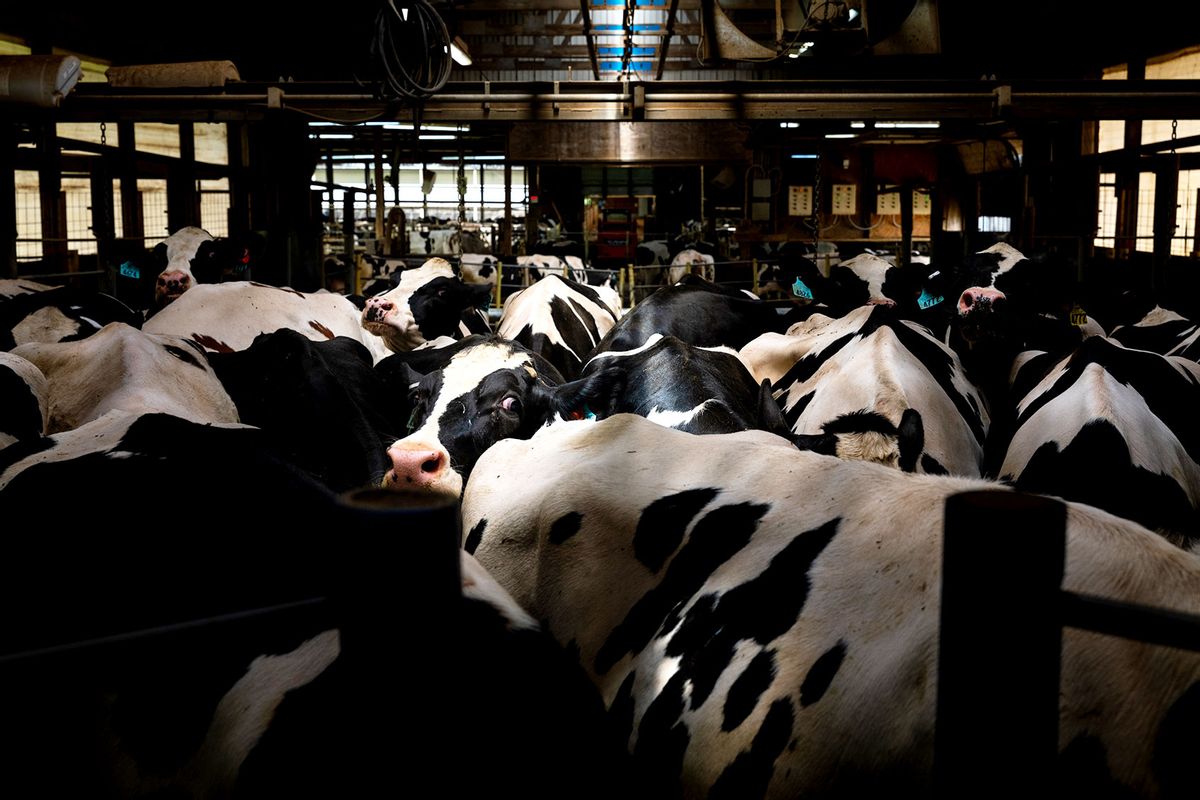In late March, a worker on a commercial dairy farm in Texas developed a case of pink eye. He eventually tested positive for the highly pathogenic avian influenza Type A H5N1, also known as bird flu. Scientists were shocked to find out that cattle, not birds, were the host — and that large amounts of H5N1 were found in the infected cattle.
So far this year, there have been four confirmed cases in humans following exposure to a dairy cow, with at least 143 dairy herds affected in a dozen states. For years, scientists have warned that bird flu could become another pandemic like COVID-19 (which hasn't exactly ended.) In other species, scientists have seen H5N1 decimate populations of seals and cats. Now, a new study published in the journal Nature takes a deeper look at the virus infecting cows, shedding light on the risk it poses to the human population.
In the study, scientists found that after being isolated from an infected cow, the H5N1 virus spread to the mammary glands of mice and some ferrets.
“There's good news and bad news,” co-author of the study Keith Poulson, director of the Wisconsin Veterinary Diagnostic Laboratory, told Salon. The good news is that scientists have a model to infect laboratory animals and get them to shed the virus in their mammary glands. Specifically, in the study, scientists found that when the mice and ferrets were infected with the virus, it spread to the brain, intestines, kidney, heart and lungs. It also spread the mammary glands of mice and some of the ferrets. While transmission did not occur throughout direct contact between the mice, the female mice did transmit it to their pups through their milk.
Typically influenza viruses — like the kind that peaks every winter, but are considerably more benign than bird flu — spread among mammals through droplets in the air when an infected person coughs, sneezes or talks. This is known as respiratory transmission. The results of the study suggest the current strain isn’t great at respiratory transmission. At face value, this is good news. However, the last part of the study left scientists concerned.
“The bad news is that this will attach to both sets of sialic acid receptors,” Poulson told Salon. These receptors are prevalent throughout the upper respiratory tract of humans. In birds, H5N1 strains typically attack different sialic acid receptors. But now it has clearly adapted to mammalian receptors, which could give the virus greater capacity for transmission between people.
One of the main reasons H5N1 hasn't become a pandemic yet — emphasis on yet — is because it is kind of lousy at spreading from person to person. If it ever evolves that ability, a distinct possibility, it could then easily surge through a population, creating a textbook pandemic. In fact, this is exactly what SARS-CoV-2, a virus that first existed in bats, managed to do in 2019.
“So we really need to pay attention to this virus; we can't let it continue to be endemic in our dairy herds," Poulson said.
"We really need to pay attention to this virus."
Indeed, in the last part of the study scientists discovered that unlike older strains of H5N1, this one has the capacity of “dual binding,” which suggests that it could be possible for humans to get infected in their respiratory tracts — but the scientists said they need more information.
Poulson said in light of the findings, he thinks it’s a good idea that last week, the Human Services announced a contract with the vaccine developer Moderna to manufacture an mRNA vaccine that targets bird flu. “We have successfully taken lessons learned during the COVID-19 pandemic and used them to better prepare for future public health crises,” HHS Secretary Xavier Becerra said in a statement. "As part of that, we continue to develop new vaccines and other tools to help address influenza and bolster our pandemic response capabilities."
“We don't want to get caught behind the eight ball like we did with COVID,” Poulson said. “It's worth the prep, so if this were to change, even though it's a very low chance, if it were to change, we're ready for it.”
Want more health and science stories in your inbox? Subscribe to Salon's weekly newsletter Lab Notes.
Professor Ian Brown of The Pirbright Institute, who leads a research consortium that is addressing similar questions on receptor binding, said in a media statement that the “predicted binding to cells offers new evidence for wider attachment including to cells lining the upper respiratory tract of humans but requires further study to understand the underlying factors.”
“Overall the study findings are not unexpected but this report provides further science insight to an evolving situation,” he said. “That emphasizes the need for strong monitoring and surveillance in affected or exposed populations, both animals and humans to track future risk.”
Dr. Rajendram Rajnarayanan of the New York Institute of Technology campus in Jonesboro, Ark., told Salon he is concerned about the latest study’s findings, but the concern isn't “alarming” just yet.
“There are the things that we expect that's going to happen when we do not control the spread,” Rajnarayanan said. “There is a possibility that if it binds right now, it's going to try to bind better. It's always going to mutate and that’s a key concern.”
We need your help to stay independent
Genomic surveillance, Rajnarayanan said, is key to getting ahead of efficient human-to-human respiratory transmission.
“Typically, anything that infects the upper respiratory tract, their ability to transmit human to human, is pretty high,” Rajnarayanan said. “So far, we haven't seen that yet, but what we have seen is that this is able to bind to both receptors. That's the information we have right now.”
How efficiently they bind is what scientists should be looking for next. “Once it hits human-to-human transmission, it's going to spread much like what we have seen in other pandemic-potential viruses,” he said.



Shares